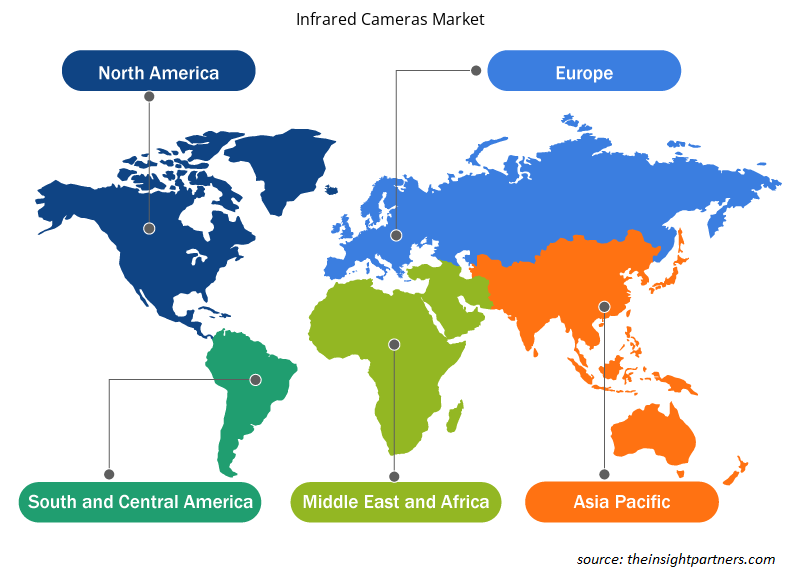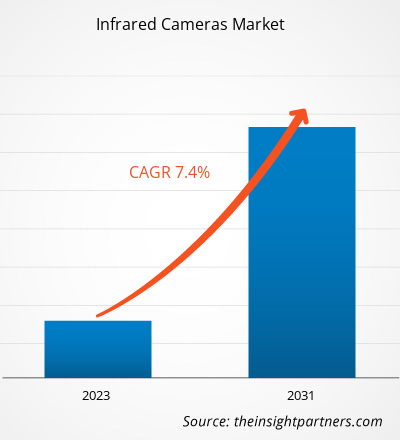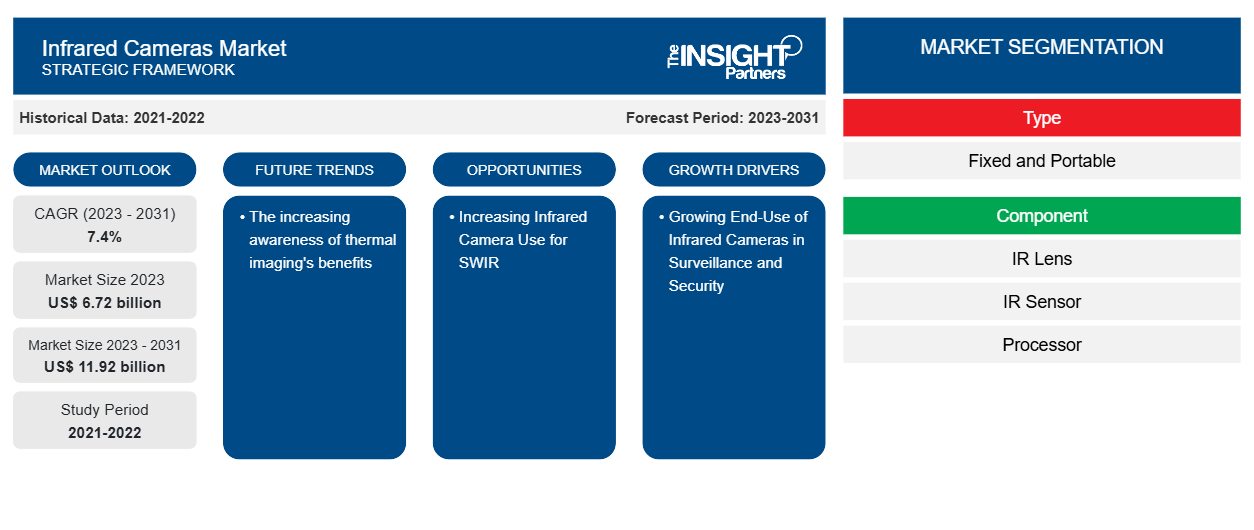Se proyecta que el tamaño del mercado de cámaras infrarrojas alcance los 11.920 millones de dólares estadounidenses para 2031, desde los 6.720 millones de dólares estadounidenses en 2023. Se espera que el mercado registre una CAGR del 7,4 % entre 2023 y 2031.Es probable que la creciente conciencia de los beneficios de la termografía siga siendo una tendencia clave en el mercado de las cámaras infrarrojas.
Análisis del mercado de cámaras infrarrojas
El mercado de las cámaras infrarrojas ha crecido significativamente en todo el mundo debido a una variedad de usos en sectores como la atención médica, la automoción y la seguridad. Al proporcionar medición de temperatura sin contacto, visión nocturna e identificación de defectos, las cámaras infrarrojas mejoran la eficacia operativa. Gracias a las mejoras tecnológicas, las cámaras con mejor calidad de imagen ahora son más pequeñas y tienen un precio más razonable. A medida que más sectores comprendan los beneficios de las imágenes infrarrojas para la eficiencia energética, la vigilancia y el mantenimiento predictivo, el mercado está preparado para un crecimiento futuro. Sin embargo, todavía existen problemas con la regulación y la competencia que afectan la dinámica del mercado. Se prevé que la innovación continua y el uso industrial creciente mantendrán la tendencia al alza del mercado.
Descripción general del mercado de cámaras infrarrojas
Las cámaras infrarrojas se utilizan ampliamente en aplicaciones de vigilancia y seguridad. Incluso en total oscuridad, pueden detectar movimiento y tomar fotografías térmicas. Por lo tanto, se pueden utilizar para vigilar grandes espacios, detectar intrusos y detener robos y actos vandálicos.
Además, al integrar estas cámaras con análisis de video de vanguardia, se pueden fortalecer la identificación de amenazas y los protocolos de seguridad generales. Algunas cámaras de seguridad incluyen tecnología de infrarrojos inteligentes. Este método elimina el problema de que un objeto sea demasiado brillante al ajustar el brillo de los LED infrarrojos en función de la distancia del objeto a la cámara. Resuelve el problema de que los LED infrarrojos oculten las fotos cuando los objetos están muy cerca de la cámara.
Personalice este informe según sus necesidades
Obtendrá personalización en cualquier informe, sin cargo, incluidas partes de este informe o análisis a nivel de país, paquete de datos de Excel, así como también grandes ofertas y descuentos para empresas emergentes y universidades.
-
Obtenga las principales tendencias clave del mercado de este informe.Esta muestra GRATUITA incluirá análisis de datos, desde tendencias del mercado hasta estimaciones y pronósticos.
Impulsores y oportunidades del mercado de cámaras infrarrojas
Uso creciente de cámaras infrarrojas en vigilancia y seguridad
La seguridad pública recibe la máxima atención en todo el mundo. Los grupos de seguridad pública están invirtiendo en una variedad de tecnologías de vanguardia para garantizar su eficacia. En respuesta al aumento de la delincuencia, el comportamiento antisocial y los ataques terroristas, el gobierno ha puesto en marcha tecnologías y medidas de seguridad innovadoras. Ahora es esencial crear soluciones viables, seguras y asequibles, así como mejorar la capacidad del sistema para responder a ataques catastróficos.
Además, se están utilizando diversas cámaras infrarrojas para vigilancia perimetral, cumplimiento de la ley, seguridad nacional y monitoreo de defensa. El mercado está creciendo debido a características mejoradas como gran rendimiento, capacidades de imagen mejoradas y alta confiabilidad. Para establecer un sistema de vigilancia integral, estas cámaras también se pueden conectar con dispositivos de posicionamiento de movimiento horizontal y vertical.
Aumento del uso de cámaras infrarrojas para SWIR
Las principales aplicaciones de las cámaras infrarrojas refrigeradas son los rangos largos y medios. Pero a medida que la tecnología avanza más, estas cámaras infrarrojas se utilizan para aplicaciones en espacios más reducidos. Las matrices de plano focal InGaAs con baja corriente oscura y recuentos de píxeles deficientes se utilizan en cámaras infrarrojas refrigeradas. Las cámaras infrarrojas se utilizan para mediciones de metrología SWIR para aplicaciones finales de corto alcance. Además, estas cámaras infrarrojas de corto alcance permiten niveles de ruido bajos de aproximadamente 220 cuadros por segundo. Numerosas empresas están desarrollando productos para longitudes de onda medias y largas, así como para rangos cortos. Para una variedad de aplicaciones, las cámaras infrarrojas para SWIR mejoran la vista y fomentan la refrigeración pasiva. Se espera que estas cámaras de corto alcance se utilicen para perfilado de rayos láser, espectroscopia , imágenes hiperespectrales e inspección de semiconductores.
Análisis de segmentación del informe de mercado de cámaras infrarrojas
Los segmentos clave que contribuyeron a la derivación del análisis del mercado de cámaras infrarrojas son el tipo, el componente, la longitud de onda y la aplicación.
- Según la oferta, el mercado de cámaras infrarrojas se segmenta en fijas y portátiles. El segmento fijo tuvo una mayor participación de mercado en 2023.
- Por componente, el mercado está segmentado en lentes IR, sensores IR, procesadores y otros.
Por longitud de onda, el mercado se segmenta enRadiación de onda larga (LWIR), onda media (MWIR), onda cercana (NIR) y onda corta (SWIR).
Por aplicación, el mercado está segmentado en electrónica de consumo, seguridad y vigilancia, aeroespacial y defensa, entre otros. El segmento de seguridad y vigilancia tuvo una mayor participación de mercado en 2023.
Análisis de la cuota de mercado de las cámaras infrarrojas por geografía
El alcance geográfico del informe de mercado de cámaras infrarrojas se divide principalmente en cinco regiones: América del Norte, Asia Pacífico, Europa, Oriente Medio y África, y América del Sur/América del Sur y Central. En términos de ingresos, APAC representó la mayor participación en el mercado de cámaras infrarrojas. Dado que la necesidad de sistemas de seguridad y vigilancia ha aumentado, las empresas de una variedad de industrias han llegado a comprender lo importantes que son las cámaras infrarrojas para garantizar una detección eficiente. Debido a la disponibilidad de tecnologías sofisticadas y mejoradas, el aumento de la demanda de electrónica inteligente y la expansión del sector industrial, este es el mercado más lucrativo para las cámaras infrarrojas.
Perspectivas regionales del mercado de cámaras infrarrojas
Los analistas de Insight Partners explicaron en detalle las tendencias y los factores regionales que influyen en el mercado de cámaras infrarrojas durante el período de pronóstico. Esta sección también analiza los segmentos y la geografía del mercado de cámaras infrarrojas en América del Norte, Europa, Asia Pacífico, Oriente Medio y África, y América del Sur y Central.

- Obtenga datos regionales específicos para el mercado de cámaras infrarrojas
Alcance del informe de mercado de cámaras infrarrojas
| Atributo del informe | Detalles |
|---|---|
| Tamaño del mercado en 2023 | 6.720 millones de dólares |
| Tamaño del mercado en 2031 | US$ 11.92 mil millones |
| CAGR global (2023 - 2031) | 7,4% |
| Datos históricos | 2021-2022 |
| Período de pronóstico | 2023-2031 |
| Segmentos cubiertos |
Por tipo
|
| Regiones y países cubiertos |
América del norte
|
| Líderes del mercado y perfiles de empresas clave |
|
Densidad de actores del mercado de cámaras infrarrojas: comprensión de su impacto en la dinámica empresarial
El mercado de cámaras infrarrojas está creciendo rápidamente, impulsado por la creciente demanda de los usuarios finales debido a factores como la evolución de las preferencias de los consumidores, los avances tecnológicos y una mayor conciencia de los beneficios del producto. A medida que aumenta la demanda, las empresas amplían sus ofertas, innovan para satisfacer las necesidades de los consumidores y aprovechan las tendencias emergentes, lo que impulsa aún más el crecimiento del mercado.
La densidad de actores del mercado se refiere a la distribución de las empresas o firmas que operan dentro de un mercado o industria en particular. Indica cuántos competidores (actores del mercado) están presentes en un espacio de mercado determinado en relación con su tamaño o valor total de mercado.
Las principales empresas que operan en el mercado de cámaras infrarrojas son:
- Leonardo
- Industrias Optronicas Opgal Ltd
- Teledyne DALSA
- Buscador Térmico, Inc.
- LINDO
- Sistemas Thermoteknix Ltd.
Descargo de responsabilidad : Las empresas enumeradas anteriormente no están clasificadas en ningún orden particular.

- Obtenga una descripción general de los principales actores clave del mercado de cámaras infrarrojas
Noticias y desarrollos recientes del mercado de cámaras infrarrojas
El mercado de cámaras infrarrojas se evalúa mediante la recopilación de datos cualitativos y cuantitativos posteriores a la investigación primaria y secundaria, que incluye publicaciones corporativas importantes, datos de asociaciones y bases de datos. A continuación, se incluye una lista de novedades en el mercado de trastornos del habla y el lenguaje y estrategias:
- En enero de 2024, Samsung Electronics presentó los Galaxy S24 Ultra, S24+ y S24, que prometen nuevas experiencias móviles con Galaxy AI. La serie Galaxy S pretende repensar la atención al cliente con IA. Ofrece funciones como interpretación inteligente de textos y llamadas para una comunicación constante, mayor libertad creativa a través de ProVisual Engine y capacidades de búsqueda más desarrolladas para encontrar el mundo que los rodea. (Fuente: Samsung Electronics, nota de prensa)
- En enero de 2024, Valeo y Teledyne FLIR, una división de Teledyne Technologies Incorporated, iniciaron una asociación estratégica para introducir la innovación en termografía en el sector de la automoción, con la esperanza de seguir desarrollando la seguridad de los usuarios de la carretera. (Fuente: Valeo, nota de prensa)
Informe de mercado sobre cámaras infrarrojas: cobertura y resultados
El informe “Tamaño y pronóstico del mercado de cámaras infrarrojas (2021-2031)” proporciona un análisis detallado del mercado que cubre las siguientes áreas:
- Tamaño del mercado y pronóstico a nivel global, regional y nacional para todos los segmentos clave del mercado cubiertos bajo el alcance
- Dinámica del mercado, como impulsores, restricciones y oportunidades clave
- Principales tendencias futuras
- Análisis detallado de las cinco fuerzas de Porter y PEST y FODA
- Análisis del mercado global y regional que cubre las tendencias clave del mercado, los principales actores, las regulaciones y los desarrollos recientes del mercado.
- Análisis del panorama de la industria y de la competencia que abarca la concentración del mercado, el análisis de mapas de calor, los actores destacados y los desarrollos recientes
- Perfiles detallados de empresas
- Análisis histórico (2 años), año base, pronóstico (7 años) con CAGR
- Análisis PEST y FODA
- Tamaño del mercado, valor/volumen: global, regional y nacional
- Industria y panorama competitivo
- Conjunto de datos de Excel
Informes recientes
Testimonios
Razón para comprar
- Toma de decisiones informada
- Comprensión de la dinámica del mercado
- Análisis competitivo
- Información sobre clientes
- Pronósticos del mercado
- Mitigación de riesgos
- Planificación estratégica
- Justificación de la inversión
- Identificación de mercados emergentes
- Mejora de las estrategias de marketing
- Impulso de la eficiencia operativa
- Alineación con las tendencias regulatorias























 Obtenga una muestra gratuita para - Mercado de cámaras infrarrojas
Obtenga una muestra gratuita para - Mercado de cámaras infrarrojas